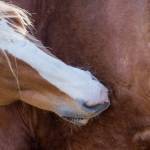Novel Immunotherapy Protocol Improves Insect Bite Hypersensitivity in Horses

Using a pool of nine different Culicoides allergens, veterinarians developed an allergen immunotherapy (AIT) protocol. This protocol, which involved administering only a few injections under the skin per year, proved to be a promising treatment approach to insect bite hypersensitivity (IBH) in horses.
“IBH is a severe allergic reaction to the saliva of the small, flying midge called Culicoides. These tiny insects can cause a great deal of damage to a horse’s skin and coat,” said Catherine Whitehouse, M.S., a nutrition advisor for Kentucky Equine Research.
Approximately 10% of horses are affected by IBH, but that number can increase to 50% in certain populations of Icelandic horses. Classic signs of IBH, also called sweet itch, include extreme itchiness, broken hairs, patchy hair loss, and scaling or oozing skin lesions.
“This condition negatively affects the horse’s quality of life. Further, owners find this allergic condition frustrating given how much effort we put into managing affected horses with fly protection, strategic turnout routines, and potential feed and supplement programs,” explained Whitehouse.
Prior studies attempted to use “whole body extracts” from Culicoides to create an injection that can be used for AIT. Those efforts, however, were unsuccessful. Not to be thwarted, Graner and colleagues took a different approach and handcrafted a protocol that used nine different allergens isolated from the salivary glands of various species of Culicoides.* That mixture was injected subcutaneously in nine horses diagnosed with IBH three times in one summer and again twice the following summer. Eight additional horses with IBH were included in a control group and were left untreated.
An IBH lesion score, an itchiness score, and an assessment of overall hair coat and skin quality were determined in the summer before beginning treatments, and again in each of the two following summers when horses received AIT (for a total of three summers).
Key findings observed:
- A reduction in IBH lesion score was observed in both the treatment and control groups in the first treatment year compared to the pretreatment year. Specifically, 67% of the AIT and 25% of the control horses had a greater than 50% improvement in IBH lesion score.
- The change in IBH lesion score between the first treatment year and pretreatment year, however, was significantly greater in the AIT group compared to the control group.
- In the second treatment year, the effect of AIT was more pronounced. IBH lesion score was significantly lower in the treatment group than the control group.
- The IBH lesion score decreased significantly between the first and second treatment years. In the second treatment year, 89% of AIT horses, but only 14% of control horses, had a greater than 50% improvement in the IBH lesion score in the second year compared to the pretreatment year.
- Itchiness scores and assessment of hair coat and skin also improved in the AIT group compared to the control group.
“These results are exciting because there are no known effective treatments for AIT,” Whitehouse said.
This approach, according to the researchers, offers a cost-effective way of managing IBH. Based on these results, AIT should be performed for at least two years, which is a common treatment plan in other species. AIT was safe in all horses except for a few horses with small, local swellings at the injection site.
“Nutritional support for horses suffering from IBH may include supplementing with long-chain omega-3 fatty acids as they can support the immune system as well as skin and coat health,” advised Whitehouse. Choose EO-3 for a direct source of DHA and EPA, two of the most biologically active long-chain polyunsaturated fatty acids. In a study conducted by Kentucky Equine Research, daily intake of EPA and DHA from EO-3 significantly increased RBC membrane EPA and DHA, but a similar amount of omega-3 in the form of ALA from flax (linseed) oil did not.
*Graner, A., R.S. Mueller, J. Geisler, D. Bogenstätter, S.J. White, S. Jonsdottir, and E. Marti. 2024. Allergen immunotherapy using recombinant Culicoides allergens improves clinical signs of equine insect bite hypersensitivity. Frontiers in Allergy 5:1467245.








